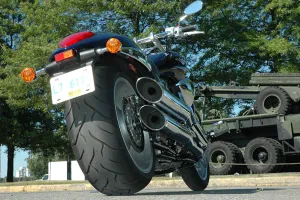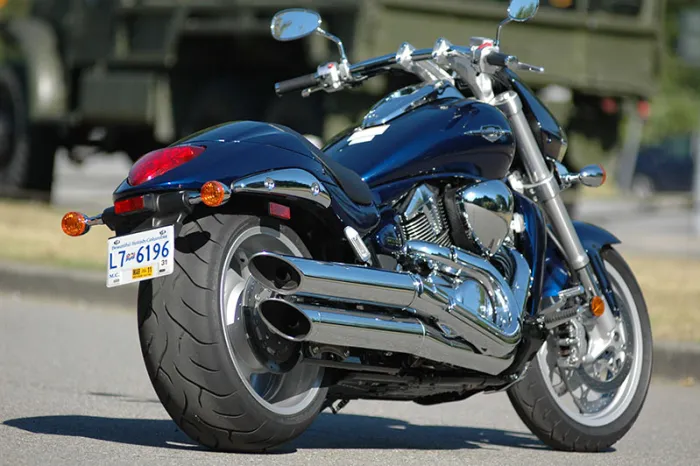It’s been with us since 2006, and in that time Suzuki’s Boulevard M109R has established itself as a charter member in the elite power cruiser class. More than that, it has lent the category definition while delivering a knockout punch on the quarter mile. Here, we revisit the reasons why we love the brute.
The Suzuki Boulevard M109R has the feel of an S&S Super Sidewinder, punching out big-chested V-Twin pulses that arrive with a thump and a bang: 127 horsepower at 6,200 rpm and 118 ft/lbs. torque at 3,200 rpm depending on whose dyno you believe.Flat-top pistons run short-stroked through a 4.5-inch bore. If you’re lazy with the long-throw clutch in the low-range gears, massive engine braking will stop you on the spot, upset whatever “line” you thought you were driving through and send a kick through the underpinnings all the way back to the 240 Sportmax.
You have to respect the M109R or it will eat you alive: every ounce of its formidable power comes on right now and given the particular nature of its clutch operation, a constant vigil is mandatory in the shifts between neutral and first, first up to second, and back down again. Blow the shift and it will seem like a bag of cement dropped on the driveline. The highway is nothing. The 109 cubic inch V-Twin motor from which the Suzuki Boulevard takes its name settles into a mile-eating lope with almost no prompting: in top gear a pulse is just barely visible on the tach as you roll the throttle to heat-score proportions. It wouldn’t take much work to lose your licence.

As metrics go, it just doesn’t seem like one. The power isn’t “seamless” or “buttery-smooth,” it’s raw and rough as a cob. A shootout in the power cruiser class—there are only six, maybe seven, production bikes in the world that can lay legitimate claim to being in that elite group—conducted last year by Popular Mechanics put the M109R only slightly behind the 2,200cc Rocket III and its bulging 150 ft/lbs. torque. PM’s test took in a rising scale of timed acceleration parameters on the quarter-mile strip at 2,800 feet above sea level: zero to 30 mph, zero to 60, 40 to 70 mph and, finally, elapsed time and top speed in the quarter-mile.
But from a pure street level perspective, I found results in the zero to 60 bracket to be the most enlightening, and probably the most useful. With former 250GP rider Danny Coe in the pilot’s seat, the M109R hammered out a blistering 3.89-second zero to 60 run against the Triumph’s 3.66 seconds. In a group that also consisted of the Harley-Davidson Night Rod Special, Honda VTX 1800F, Kawasaki Vulcan 2000, Victory Hammer S, and the Yamaha Road Star Warrior, the rest didn’t even come close. The third best time belonged to the Night Rod at 4.26 seconds. Surprisingly, the Vulcan brought up the rear: 4.98 seconds.
And yes, the Rocket III and the M109R were clear victors in the other brackets as well: the Triumph notching 11.99 sec. at 111 mph in the quarter-mile against the Suzuki’s 12.08 sec./110.53 mph. Interestingly, the M109R recorded the best time in the zero to 30 mph parameter.
The full weight of its 765 pounds evaporates during most running times—it cuts a fine figure eight—but surfaces at unexpected moments. I was on a long straight highway section with stiff front-quartering wind gusts, where the simple act of hanging on proved a challenge. The bike felt full and heavy. Perhaps the sheer mass of its distinctive front end played a role, created G-forces as the bike forged on under a head of steam, its profile further distinguished by integrated side covers, a voluminous rad cowl, and a fat streamlined tank that empties its 4.18 imp. gallons (19.5 litres) with startling alacrity. But, under the prevailing conditions, I didn’t ride the Suzuki so much as tussle with it through thick bars that spread the operator’s arms into the final stroke position of a wide-grip lat pulldown.

Power cruisers by their very nature are heavy beasts with incredible forward momentum when they’re cut loose. So, the M109R is fitted with big front double discs and beefy calipers stuffed with multiple pistons. Suzuki says it configured radial-mount Tokico calipers from its Supersport GSX-R1000 program to provide the M109R’s stopping force. This is not difficult to believe. The bite is deep, hard and lasting with none of the spongy or even wooden feel at the lever offered by others in the class.Are there better brakes in the power cruiser category? I don’t think so.
None of this is news, of course. The M109R has been with us since 2006 and has remained generally the same since its introduction. But it was, and still is, an important bike because of its role in bringing clarity to the power cruiser segment which had been, till then, only vaguely defined.
And though its essential nature is that of a brute, and despite that it’s a power cruiser that I personally found the most challenging in the category to tame, revisiting a bike like the M109R is purely a joy and we do it … well … because we can.
Original Article at CDNDKR
